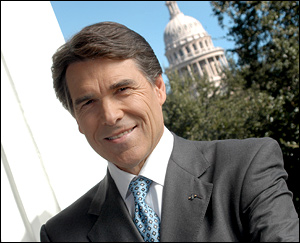Texas Gov. Rick Perry (R), speaking from a key financial supporter’s Caterpillar plant who also happens to be the majority owner of the San Antonio Spurs professional basketball franchise, yesterday ended speculation about his political future. Perry, standing behind a podium on a stage surrounded by American and Lone Star State flags, made public his intention to retire from the governorship when this current term ends, but left the door wide open for another presidential run.
The governor faced a conundrum about whether to keep his current position while attempting another run for the nation’s top office. In his situation, considering the context of the original Perry national campaign that ended in disaster, the decision over whether to seek re-election was more difficult than for most politicians in a similar situation. Usually, attempting to execute the duties of one political office while running for president is often a disqualifying factor but, in Gov. Perry’s case, the credibility he would have earned from winning yet another term in statewide office and the financial base that such position provides made his decision difficult.
Late last week, Perry transmitted an email to supporters indicating that he would formally announce a decision regarding his political future. The secret was well guarded to the point that no leak occurred about what would actually be announced. It seemed as many Perry supporters believed the governor would retire as felt he would seek a fourth full term.
In culmination, Rick Perry had nothing left to prove as governor. When this term ends, he will have served 14 years as Texas’ chief executive, more than double the time that anyone else has held the office. Until 1982, the state restricted its governors to one four-year term. Even when legislation was passed eliminating term limits, it took until 1998 for Texas’ voters to actually re-elect a governor, and that individual was George W. Bush.
The Perry record is strong. As he mentioned in his retirement address, over 30 percent of all jobs created in America since he became governor have occurred in Texas. The Lone Star economy is robust, while the nation’s economic numbers sink. It was his economic record that propelled him to the forefront of the 2012 Republican presidential field, and kept him as perhaps Continue reading >



